ED016. Effects of fire on the bee community in the grassland of the Atacazo steppe, Ecuador
Main Article Content
Abstract
Disturbances, like fire represent a source of danger for the paramount and its ecosystemic services. One of the main services that insects provide for this ecosystem is pollination. To measure the effects of fire over bee communities in the grasslands of Ecuadorian paramount, a total of 60 traps (pan trap, yellow, white, and blue) were distributed across the two treatments considered for this study: burned grasslands and conserved grasslands in Atacazo volcano, Pichincha, Ecuador. Samples were collected from March to May 2021. We collected a total of 149 individuals, those belong to 8 species of 5 different genera. Species accumulation curve suggests that species richness is higher in burned grasslands than in conserved grasslands. There were not differences in the dominance, but the entropy was higher in the conserved treatment. The species composition was similar with a lot of overlapping in both treatments. This results suggest that there are not significant differences in the comparison between burned grasslands and conserved grassland.
Downloads
Metrics
Article Details

This work is licensed under a Creative Commons Attribution-NonCommercial 4.0 International License.
The authors who publish in Siembra know and accept the following conditions:
- Authors retain the copyright and grant Siembra the right of first publication of the work, under the Creative Commons Attribution License. Third parties are allowed to use what has been published as long as they refer to the author or authors of the work and its publication in this journal.
![]() This content is licensed under a Creative Commons Attribution-Noncommercial 4.0 International (CC BY-NC 4.0).
This content is licensed under a Creative Commons Attribution-Noncommercial 4.0 International (CC BY-NC 4.0).
- Authors maintain the copyright and guarantee Siembra the right to publish the manuscript through the channels it considers appropriate.
- Authors may establish on their own additional agreements for the non-exclusive distribution of the version of the work published in Siembra, acknowledging their initial publication in the same, such as in institutional repositories.
- Authors are authorized to disseminate their work electronically once the manuscript is accepted for publication.

